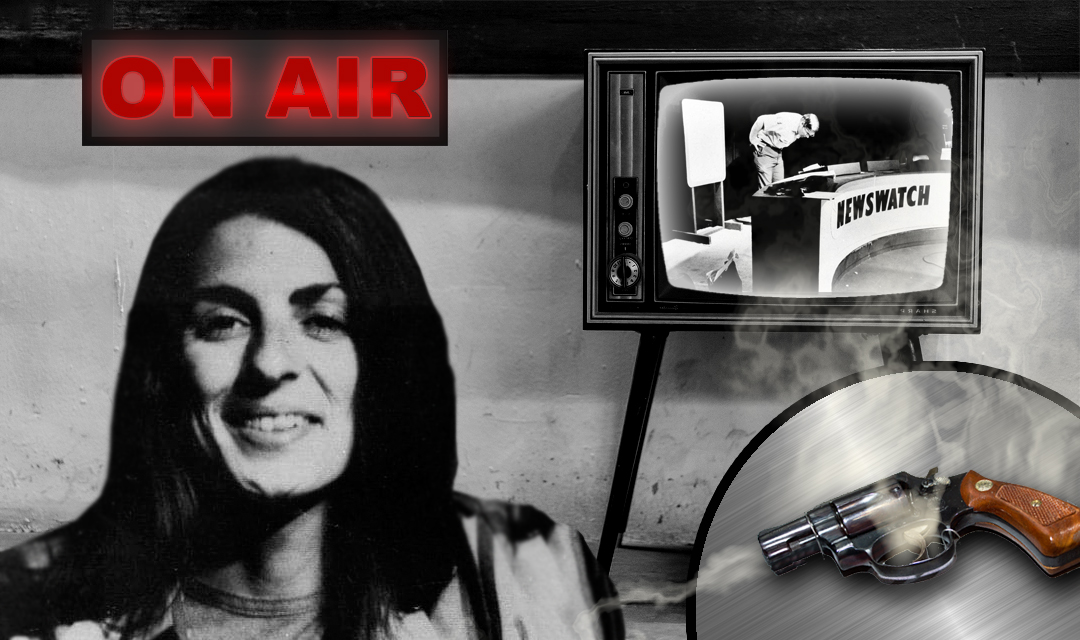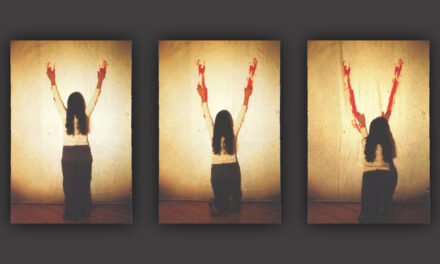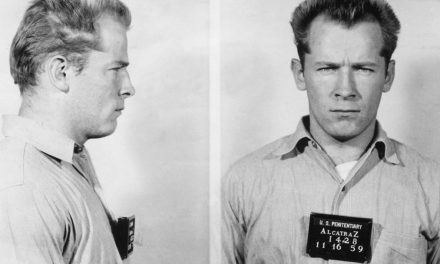A TELEVISION FIRST
She died with a captive audience.
Eight minutes into her program, on-air reporter Christine Chubbuck said coolly but with one barely visable, trembling hand on her script: “In keeping with Channel 40’s policy of bringing you the latest in blood and guts and in living color, you are going to see another first–-attempted suicide.”
Television cameras zoomed in on her as she held the 38 caliber Smith and Wesson revolver behind her right ear and fired. With that shot she captured her audience. She fell violently to the floor and the screen went to black. Thousands of people in central Florida watching the “Suncoast Digest” on the morning of July 15, 1974, witnessed the first suicide aired on television.
It was her final attempt to connect with the real world that she always felt evaded her. That might have been enough for a woman who felt invisible to everyone except her family.
Romance, work promotions, sex, marriage, children, friends, praise for good work at her job as a reporter apparently did not abound in Christine Chubbunk’s life. So she ended it. The first suicide on television by a newscaster was viewed by the only people she could count on to show up.
Christine Chubbuck rarely had a second date. She was almost 30, a virgin, almost lovely, yet a person who repelled friends or lovers. In high school she started a club for “Dateless Wonders”. She was a reporter for a second-rate station, doing news and features, and going nowhere, for $5000 a year. Christine was good at her job, efficient. But she hated her boss, Robert Nelson, and his insistence that sensational stories be the focus of the struggling young station’s news stories, including hers..
Well, she showed him. And everyone who had ever hurt or ignored her. “Christine finally got the attention she craved,” said her mother.
“Chubbuck spoke to her family at length about her struggles with depression and suicidal tendences, though she did not inform them of her intent to commit suicide on live television. She had attempted to overdose on drugs in 1970 and frequently made reference to that event. Chubbuck had been seeing a psychiatrist up until several weeks before her death. Her mother chose not to tell WXLT management about her daughter’s suicidal tendencies because she feared Chubbuck would be fired.”
“Chubbuck’s focus on her lack of intimate relationships is generally considered to be the driving force for her depression. Her mother later summarized that “her suicide was simply because her personal life was not enough.”
Chubbuck’s lack of a romantic partner was considered a tangent of her desperate need to have close friends, though co-workers said she tended to be brusque and defensive whenever they made friendly gestures toward her. She was self-deprecating, criticizing herself constantly and rejecting any compliments others paid her.”
Wikipedia, Current Content of January 15, 2022
PREPARATION FOR A SHOCKING ACT
She not only had suicidal thoughts for a long time, but a propensity for planning her final exit.
As she thought more about ending her life, part of her planning was disguised as a feature story on suicide using an interview with a local Deputy Sheriff. Her questions? Just how was it effectively done, what kind of gun was often used, where did they aim to know they’ll hit the target?
Around this time, a week before the fateful day, Chubbuck told night news editor Rob Smith that she had bought a gun. She joked about killing herself on air. Smith later said that he did not respond to what he thought was Chubbuck’s “sick” attempt at humor, and changed the subject.
With clever forethought, she smuggled in the gun in a bag of puppets she sometimes used on her show. Everything seemed completely normal.
Except, co-workers said, she was unusually cheerful, even sitting on the lap of her sometimes co-newscaster’s lap, flirting happily with someone who had previously rejected her. Her brother, Greg said Chubuck seemed happy lately… “Besides, her mood seemed up Saturday and Sunday, she baked a cake. She improved her tan.”
“I guess she was putting her house in order,” said her mother.
Chubbuck had even written the script to be read after the shooting.
Mike Simmons, TV-40 news director, quoted in The Dallas Morning News
Later colleagues said Chubbuck surely wrote “critical condition” instead of “was pronounced dead” because she was known as an exacting reporter, she wanted to be accurate and not assume her death. After all she called it an “attempted suicide.”
On the morning of July 15, 1974, Chubbuck also confused co-workers by claiming she had to read a newscast to open “Suncoast Digest”, something she had never done before. After reading a few news stories she read the script that she alone had prepared and approved.
According to her brother Greg she must have planned to spare some family viewers.
Christine Pelisek, People Magazine, February 11, 2016
Some of the most vivid reportage on her death includes an extensive article in the Washington Post in 2016, as her case became famous again through film. That article reprinted some of the coverage from the time, including earlier reporting by Sally Quinn.
“Her right arm stiffened, ‘We bring you another first.’ Her voice was steady. She looked up again to the camera. Her eyes were dark, direct and challenging. ‘An attempted suicide.’ Her right arm came up from under the anchor desk. In it was a .38 caliber revolver. She pointed it at the lower back of her head and pulled the trigger. A loud crack was heard. A puff of smoke blew out from the gun and her hair flew up around her face as if a sudden gust of wind had caught it.
“Her face took on a fierce, contorted look. Her mouth wrenched downward, her head shook. Then her body fell forward with a resounding thud against the anchor desk and slowly slipped out of sight.”
Sally Quinn, reprinted in Washington Post, February 16, 2016
Only a few days before her suicide, Chubbuck had done one of the most social, outgoing things ever in her life. She hosted a party at her home–it’s said about 30 attended–and was reported to be a good hostess, happy. Later, friends, and co-workers realized that in her own, odd way, Christine was saying goodbye.
TRAGEDY MEMORIALIZED IN FILM
The incident is coming to light once again, however, after two movies about her life premiered at Sundance. One is the feature “Christine,” which stars Rebecca Hall as the journalist, and follows her depressive spiral. The second is the documentary “Kate Plays Christine,” about an actress who gets a job to play the newscaster in another project, then moves to Sarasota to investigate Chubbuck’s life.’
Amy Argetsinger and Stephanie Merry, Washington Post February 16, 2016
Chubbuck’s death made headlines around the country and oddly inspired the 1976 film “Network” starring Faye Dunaway and Peter Finch. It centered on problems about content she experienced as a newscaster.
Presbyterian minister Thomas Beason delivered the eulogy, stating, “We suffer at our sense of loss, we are frightened by her rage, we are guilty in the face of her rejection, we are hurt by her choice of isolation and we are confused by her message.
Wikipedia, Current Content as of Jan. 15, 2022”
Chubbuck’s show, “Suncoast Digest,” remained on the air for some time. Not surprisingly, the station left the tragic Chubbuck ending as never-mentioned history. It seems likely that the brutal recording exists, but if so it’s unclear who has it. Some maintain that station owner Robert Nelson kept it. His widow, Mollie…does she have it among her effects? Others say the recording of Chubbuck’s suicide exists and has now been turned over to some entity, perhaps a law firm, for archiving in a secure fashion. Whoever has it, they’re not sharing the archive, perhaps for reasons of simple good taste, perhaps for additional reasons.
Understandably, Christine’s family would be horrified by the tape of her suicide used in entertainment. Another story maintains that the tape is in possession of Christine’s mother, Peg. As the documentary evidence of a stunning, tragic event, the whereabouts of the tape itself rises to the level of mystery.
WHO WAS CHRISTINE CHUBBUCK?
He has a powerful point. How many people even know that Christine survived the loss of her first, early love, from death in an automobile accident? Or that she did volunteer puppet shows for special groups, many times?
Christine Chubbuck grew up in the upscale Ohio suburb of Harbor with her parents, George and Peg, and two brothers, Tim and the younger Greg. The only daughter of a high-end automotive and manufacturing industry salesperson and a housewife, Christine was talented and smart. While in middle school, she was a flutist in the high school marching band. She later developed an interest in acting at private school and enrolled in the University of North Carolina summer acting program.
Christine was a bright, gifted student with a sharp wit and a nationally ranked kayaker, but since she was about 10 she never felt that she fit in.
Greg recalls his older brother, Tim, taking him aside and telling him their time with “Chrissie” would be short-lived.
“We have to hug Chrissie extra hard because we aren’t going to have her very long,” Greg recalls. “He was 12 and I was 8 and in the back of our minds we always knew that our time with her was not going to be infinite.”
Greg says his parents spent over $1 million, over 20 years, with psychiatrists and psychologists to “help Chrissie find peace.” In the end, of course, it wouldn’t work.
However trying her teen years were, Christine went on to earn a degree in broadcasting at Boston University, worked at a Florida cable station, and attended a summer film workshop at NYU. She later secured jobs at public television stations in Pittsburgh and Canton, Ohio. Christine moved to Florida to live with her mother after her parents divorced. She worked as a hospital computer operator before landing a job as a reporter, then a host at WXLT-TV in Sarasota, Florida.
“It was her show,” says Greg. “It was one person doing all of it with very low pay.”
Everyone in the family went out of their way to help Christine with her television career. Her mother paid for designer dresses to make sure she looked good on air. Despite having her own morning television show, Greg says his sister never felt she was good enough.
“I think, ” said her mother, “She was saying, ‘Look, world. I’ve been here all along. How about a date Saturday night? But her last act was the most selfish thing she ever did. She brought her death into other people’s homes.”
A final note on the everyman, everywoman take on this tragedy. Some of the comments posted on David Lobosco’s blog were adamant, for example, about defining Chubbuck’s mental illness, choc-full of armchair analysis. Was she bi-polar, was she on the autism spectrum, was she a classic depressive, and why? Everyone in the world, it seems, has a psychology degree.
Anonymous January 19, 2017
“I’ve seen hours of footage of her, this is CLEAR Aspergers…. depression is common among Aspies because they very often can’t understand why they cannot experience the same kind of feelings other people have…. I’ve a 25 yo daughter with Aspergers and the similarities, after watching footage of her are so uncanny….it literally scared the sh-t outta me.
Also, post operative depression is EXTREMELY common after having a unilateral oophorectomy…. I’m an RN and have seen it multiple times.
I’m beginning to think there’s something hormonal/chemical involved…. There’s simply too many women who have this acute onset of depression without ever having experienced depression before.”
Jeff Chicken June 1, 2021
“Enter the armchair psychologists who think they can diagnose autism from one written bio and an old blurry newsreel, of which there’s only one…
I have autism. I’m not going to say that Christine’s got it, because honestly, all her description really tells us is that she was socially troubled, a mentally ill spinster with a wealthy family, and that she suffered a traumatic loss as a teenager. I fail to see “autism” in this. Chalking up anybody socially awkward, introverted or unlucky in love as “autistic” seems a tad presumptuous.”
Boudicca 3 September 23, 2021
“Oh my goodness – the comments above are between those who want to label and diagnose a person they never met – Aspergers (which basically covers just about everyone on the planet) seeming to fit or bipolar – or those religious maniacs who think God should forgive her! The sad truth is likely to be much less wishy-washy and simply the fact she was lonely, didn’t have a boyfriend and felt her entire identity as a girl/woman/human being rested on being in a relationship. That idea is THE most common reason why people commit suicide including over 2000 on Mount Mihara in the 1930s. Those same people – desperately seeking a mental disorder for a very ordinary and boring human issue would most likely be the same people who think there’s something wrong with anyone who chooses to be single. So one can’t win. Truth is, the only emotions Christine herself expressed were ones of ‘not fitting in’ – a very common adolescent and early 20’s expression caused – yes caused – not by depression but a social value that says people should ‘fit in’ to something in the first place. We are all unique individuals however and what we gain and get in life is largely determined by our own attitude; however tragic, Christine Chubbuck was driven to her death by her own ego and nothing else.”
Behind the tragedy ending the life of this sincere and idealistic young woman, there will always be the most enduring mystery of all: the human psyche.



